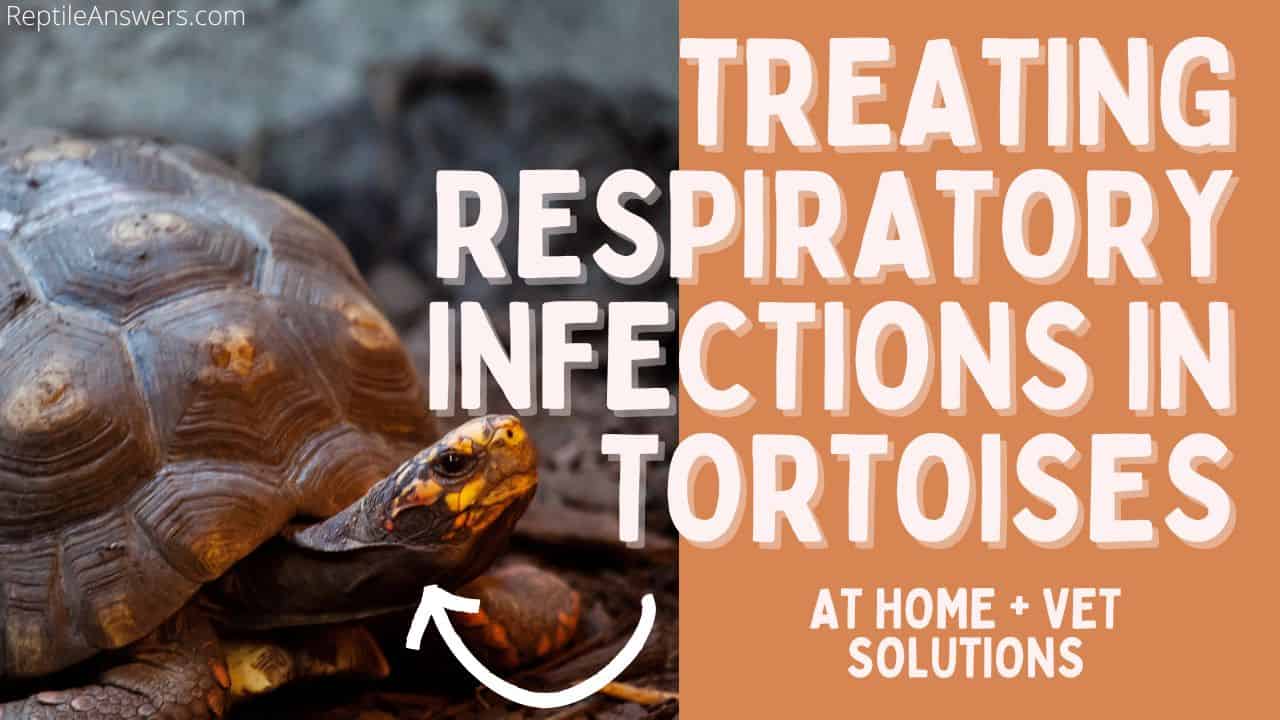Respiratory infections in tortoises can lead to difficulty breathing, discharge of the nose and mouth, and loss of appetite. In mild cases, your tortoise will recover on its own. In severe cases, you’ll need the intervention of a vet and antibiotics. This will all depend on how long your tortoise has been sick and how strong its immune system is.
Respiratory infections in tortoises are treated with antibiotics, such as enrofloxacin, ciprofloxacin, oxytetracycline, and ampicillin. They can be administered orally through injections or with nasal drops. The vet will examine the tortoise, run culture tests on discharge, and determine the cause of the infection.
If your tortoise has a mild cold, then it can be treated by you at home. Home remedies include warming up the temperature of your tortoise’s enclosure. You should soak it in warm water (85 degrees Fahrenheit) for a couple of minutes each day. Provide it with leafy greens, citrus fruits, and calcium supplements. If you catch it early enough, your tortoise should recover within a few days.

Tortoise Respiratory Infection Treatment
Respiratory infections can spread throughout their upper and lower respiratory tracts. According to the Journal of Herpetological Medicine and Surgery, the most obvious sign is lethargy. This can be followed by:
Difficulty breathingLoss of appetiteTrouble walkingOpen-mouthed breathingWhistling sounds while breathingDrainage or bubbles coming from the mouth, nostrils, and eyes
If you notice these signs, then your tortoise will need medical attention. Some respiratory illnesses can be treated at home with the use of DIY remedies. Others, especially with more severe symptoms, need to be taken to a vet.
How Do You Treat a Respiratory Infection in a Tortoise?
Most tortoise respiratory infections are treated by an exotic reptile veterinarian. That’s because these conditions often develop into more severe illnesses if left untreated. Likewise, they can escalate at a rapid pace.
Tortoises are skilled at hiding when they’re ill. Once you realize your tortoise is sick, its illness may have progressed too far. That will require the intervention of antibiotics and other treatments only a vet can provide. Once you arrive, the vet will perform these stages of treatment:
Examination and Testing
A vet will carry out a thorough examination. This will involve checking for symptoms, examining the eyes, mouth, and nose, and listening to the tortoise breathe. They will then order tests to determine the precise cause of the illness.
Testing the culture of discharge can confirm whether there’s an infection. The vet might also use X-rays to see any visible changes to your tortoise’s lungs. These X-rays will explain any breathing difficulties that your tortoise may have. If the condition is severe, they may also discuss other diagnostic tests.
Meanwhile, the vet will ask you questions about your tortoise’s lifestyle and health history to determine the nature of the infection. Being able to establish the reason behind the condition will make the condition much easier to treat.
Treatment with Antibiotics
Some vets may feel comfortable trying an oral antibiotic for a tortoise respiratory infection that is not too serious. Antibiotics are used if the infection is bacterial in nature. Your vet might suggest:
EnrofloxacinCiprofloxacinOxytetracyclineAmpicillin
A dose of 5mg per kg of body weight every other day for 10 days is the standard for oral antibiotics. Your vet might also prescribe antifungal or antiviral drugs to support the treatment.
Injectable Antibiotics
If oral antibiotics fail to work, your vet may administer an injectable antibiotic. These injections are usually given to a tortoise every 48-72 hours. This is because a tortoise’s metabolic take-up is quite slow. The drug could build up quickly inside your tortoise’s system and reach levels of toxicity otherwise.

Nasal Antibiotics
After wiping your tortoise’s nose with a disposable paper towel to remove mucus, the vet will use a syringe to instill one drop of antibiotic into each nostril.
Antibiotic drops should be given once daily. Hold the tortoise upright while administering the drops to ensure that they settle into the nasal cavity. The best time to administer antibiotic drops is late afternoon, right before your tortoise goes to sleep.
Home Care
After antibiotic therapy, your pet tortoise might still be a carrier of the respiratory infection. There is also a high chance of reoccurrence. For this reason, keep your ill or recently treated tortoise away from other healthy tortoises.
A vet’s job is to diagnose, treat, and suggest further preventive measures. After you take your tortoise home, it’s your job to combine:
The prescribed antibiotic treatmentChanges in your tortoise’s care and environment
This will include small adjustments, as well as hour-to-hour care, such as
Raising the temperature of a sick tortoise’s environment is helpful. It fortifies its body’s natural defenses to fight the infection more effectively.Ensure that you wipe away nasal discharge each time you notice it. Blocked nostrils will make your tortoise less likely to eat and set back recovery.Keep the enclosure clean and at an ideal temperature at all times.
How Long Can a Tortoise Live with a Respiratory Infection?
Tortoises are resilient animals. When they get sick with respiratory infections, they often live with and recover from them alone. Tortoises can catch colds and their immune systems will fight them off.
However, the danger is tied to possible complications. If the respiratory infection continues for too long, it may overwhelm a tortoise’s immune system. This can escalate into deadly illnesses, such as pneumonia. Factors that lead to a tortoise failing to recover from a respiratory infection include:
Poor dietBad enclosure conditionsStressPoor existing health
That’s especially true in captivity where tortoises are limited in the food and water they can access. If the humidity and temperature of their enclosure are not properly balanced, this can make the illness progress at a damaging rate. In the wild, tortoises would be subjected to more balanced temperatures that are suited to their biology. They’re native to these areas, after all, and have evolved accordingly.
If your tortoise spends several months on a diet or in an environment that doesn’t promote a strong immune system, this becomes worse. Correcting it after the tortoise has become sick can reduce how badly it’s affected by the illness. However, it will still make it hard (or even deadly) for the tortoise to live with the respiratory infection.
When Should You Treat A Tortoise Respiratory Infection?
It’s crucial to address a respiratory infection early in tortoises. Otherwise, a cold can quickly develop into pneumonia. This can lead to permanent lung damage if your tortoise recovers at all. In the worst cases, it can lead to breathing complications and eventual death from suffocation.
Once your tortoise becomes sick, you have about 3-5 weeks for hatchlings and 1-2 months for adult tortoises. During this time, you should seek treatment for the respiratory infection.
However, these numbers are just a guide. You should ideally find help for your tortoise when you notice the first signs of infection. The longer you wait, the higher the chances are of the damage becoming permanent. The good news is that, with home treatment and the intervention of a vet, your tortoise can recover within a week.
How to Cure Tortoise Respiratory Infections at Home
In mild cases, this illness is no more than a cold, much like when humans experience a runny nose and congestion. You can treat it in its early stages:
Keep the temperature in your tortoise’s enclosure around 85 degrees Fahrenheit.Maintain the basking area at between 93-95 degrees Fahrenheit.Separate infected tortoises from non-infected tortoises.Wipe your tortoise’s nose and mouth with a clean and damp cloth whenever mucus or saliva builds up.Give your tortoise a warm water soak every day to tilt out excess buildup.Ensure your tortoise is getting enough nutrition from a healthy diet.Keep the enclosure clean so that it stays free from harmful bacteria.Give natural supplements to your tortoise that target respiratory infections.
Prepare a Suitable Environment Inside the Enclosure
Once you notice a mild respiratory infection, ensure your tortoise’s enclosure is sufficiently heated. Living in mild climates is a leading cause of respiratory infections in tortoises and other reptiles. When this is coupled with high humidity levels, it’s more likely to lead to a respiratory infection.
Ensure that your tortoise’s enclosure is always at a temperature of around 85 degrees Fahrenheit. Likewise, set the basking area at a temperature between 93-95 degrees Fahrenheit.
A high temperature will enable your tortoise to relax and improve its immune system’s function. On top of that, it will allow the mucus in its body to be less viscous, so it can move around easily and leave your tortoise’s body.
Separate the Infected Tortoise
According to the University of Arizona, respiratory diseases are contagious in tortoises, able to spread from reptile to reptile. Separate the infected tortoise from the non-infected to prevent the spread of the disease. If you have multiple tortoises, make sure you have at least two enclosures – one for quarantine, one for the healthy tortoises.

Remove Saliva and Mucus
Your tortoise may not have the strength or extra air necessary to care for itself. Tortoises clean through burrowing, rubbing against plants, and soaking in water.
Because a sick tortoise will not be motivated to do this, you need to assist. This will limit the spread and growth of bacteria, which could make your tortoise even sicker. You can help your tortoise by removing the saliva and mucus from its face using a clean, damp cloth. This will make it more comfortable and cleaner.
Warm Water Soak
If your tortoise is having trouble breathing, soak it in warm water that’s around 85 degrees Fahrenheit for a few minutes. This works to keep your tortoise hydrated, open up its lungs, and soothe the discomfort of being sick.
A warm soak, accompanied by lift and tilt actions, also expels mucus from the tortoise’s nose. This enables it to breathe more easily and disinfects its body of mounting bacteria. You can even mix all-natural herbs and supplements into the warm water to help your tortoise battle the infection. Continue this practice daily to speed up recovery.
Provide a Healthy Diet
The greatest counter to a respiratory infection is your tortoise’s own immune system. The more you can fortify it, the better. This is accomplished through a balanced diet that promotes antioxidants, vitamins, and minerals.
The tortoise should have constant access to food. Otherwise, a lack of appetite can make it difficult for your tortoise to eat as much as it needs. Provide leafy and colorful food as this should entice your tortoise into drawing it near due to its color vision. Good foods include:
Dark, leafy green vegetables such as kale and spinachColorful fruits that are high in vitamin C to strengthen your tortoise’s immune system directlyCalcium powders and cuttlebone to strengthen its cells and keep active
Keep the Enclosure Clean
Clean your tortoise’s enclosure more often when it’s sick. This will allow you to remove feces, mucus, and other discharge that your tortoise produces. These may all contain high levels of bacteria, and clearing them out will give your tortoise a fresh area to recover in.
Likewise, consider thoroughly scrubbing the quarantine tank and the original one. Be sure to replace all the substrate and clean the decorations as well. There could be wilting plants, rotting food scraps, mold, or other growths in the humid corners of the tank.
These may have helped the bacteria that caused your tortoise’s illness flourish. Cleaning them out can ensure no other tortoises get sick and help your tortoise to avoid re-catching its cold.
Provide All-Natural Supplements
Look for all-natural supplements that specifically target the bacteria that cause respiratory infections. They often come in pill, powder, or paste form and can be added to your tortoise’s food. During bath time, you can also mix them into the tortoise’s soaking water. Some are effective at keeping the immune and respiratory systems in top shape.
A respiratory infection can turn into pneumonia and be life-threatening for your tortoise if you don’t address it early. If your tortoise goes for more than a few days without food and shows signs of having a cold, take immediate action. By consulting a vet and making changes to the tortoise’s environment, it could recover within a week.



